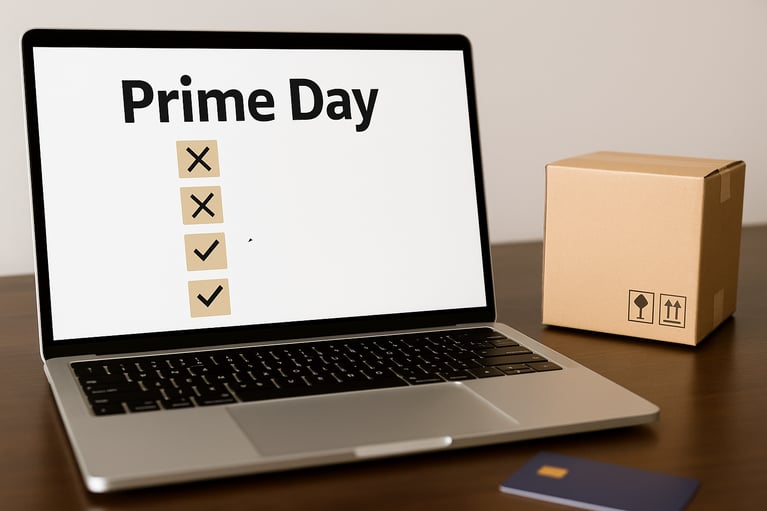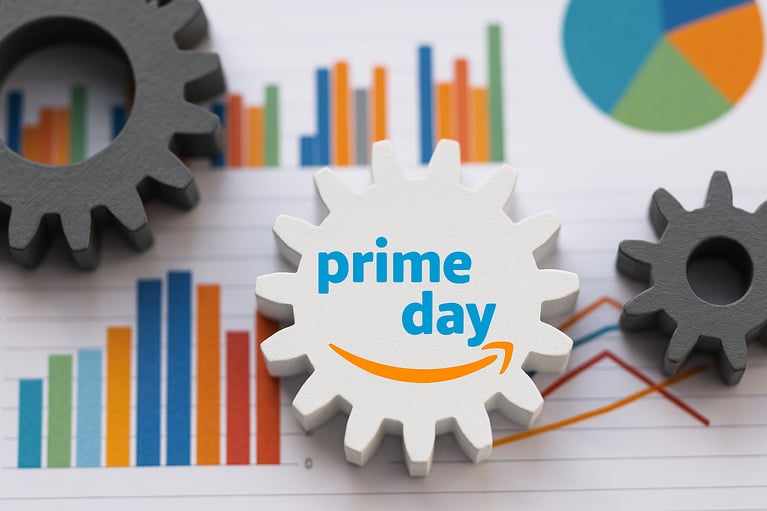It's no secret that Amazon has surpassed itself from a simple ecommerce platform into the world's most sophisticated marketplace for brands. With over 1.9 million active sellers competing for customer attention, your brand's success depends on far more than just listing products and hoping for sales.
It demands strategic brand management that goes beyond basic optimization. Additionally, without a strong brand management strategy, your listings become vulnerable to counterfeits, rogue sellers and brand erosion. With the right strategy, Amazon becomes a high-performance engine for customer acquisition, brand storytelling and sustained growth.
Looking to scale without sacrificing control? Our Growth Marketing team delivers tailored Amazon account management services that protect your brand while accelerating revenue. Let’s explore how.
What is Amazon brand management and why it matters
Amazon brand management is the strategic oversight of your brand's presence on Amazon to enhance its visibility, build customer trust and drive long-term value. Unlike traditional retail environments where you control every aspect of the customer experience, Amazon requires a nuanced approach that works within the platform's unique ecosystem while maintaining your brand's integrity and competitive edge.
Key components:
- Brand personality: Establishing a consistent tone of voice, visual identity, and storytelling across all touchpoints, from product listings to your Brand Store.
- Brand assets: Managing your intellectual property, reviews, packaging and customer experience to build trust and recognition.
- Brand strategy: Defining your brand’s unique value proposition and aligning it with how customers discover and engage on Amazon.
More importantly, strategic brand management creates compounding returns. Each optimized touchpoint reinforces your brand authority and makes your future optimization efforts more effective.
How to protect your brand on Amazon
Before scaling, protect your foundation. Amazon brand protection is a multilayered process that addresses threats before they cause damage to your reputation or erode your business.
Here are the protective protection strategies you can do now rather than reactive damage control later:
1. Enroll in Amazon Brand Registry
The Brand Registry is your first line of defense. Once enrolled, brands unlock access to tools like:
- A+ Content and Brand Stores for enhanced brand presentation
- Project Zero and Transparency for counterfeit prevention
- Report a Violation to quickly remove unauthorized sellers
To qualify for Brand Registry, you'll need a registered trademark for your brand name or logo, a branded website that showcases your products, and product packaging that clearly displays your branding.
While these requirements might seem straightforward, the trademark process can take 6-18 months through traditional channels. Amazon's IP Accelerator program can expedite this process by connecting you with vetted legal providers who specialize in Amazon trademark applications.
2. Guard against counterfeiters and unauthorized sellers
Amazon’s open nature means anyone can list your product. Without oversight, this leads to brand dilution, price erosion and poor customer experience.
Implementing proactive listing monitoring should be part of your daily brand management routine. This involves regularly searching for your brand name, product names and key identifying features to identify unauthorized listings. Use automated monitoring tools to alert you of potential violations within hours of listings going live.
For trademark violations, the Report a Violation tool can remove listings quickly. For more complex cases involving design patents or copyrights, you may need to provide additional documentation, but the protection is worth the effort.
Maintaining pricing integrity across your authorized seller network helps prevent unauthorized sellers from undercutting your brand positioning. This includes establishing minimum advertised price (MAP) policies and monitoring compliance across all sales channels, not just Amazon.
3. Maintain customer service standards
Your customer service standards directly impact your brand's reputation and your account health metrics on Amazon. Poor customer service doesn't just result in negative reviews—it can lead to account suspensions that halt all sales across your entire catalog.
Using product inserts and follow-up communications strategically can help direct customers to your support channels when they have questions or concerns. However, these communications must comply with Amazon's policies and focus on providing value rather than aggressive marketing.
Proactively responding to customer reviews and questions demonstrates your commitment to customer satisfaction. Doing so can often turn negative experiences into positive ones. Make sure to shorten your response time and answer properly, as customers notice when you engage thoughtfully.
Lastly, monitoring your seller metrics consistently helps you identify potential issues before they impact your account health. Key metrics include order defect rate, late shipment rate, and customer service dissatisfaction rate.
4. Control your brand identity
Your Amazon presence should look and feel like an extension of your website or retail store.
Create a unified brand experience that customers can easily identify and trust. This includes establishing color palettes, typography guidelines and photographic styles that remain consistent whether customers encounter your products in search results, product detail pages or your Brand Store.
Owning your brand story through cohesive A+ Content and Brand Store experiences allows you to communicate your value proposition in your own words rather than relying solely on basic product features.
Strategies to scale your brand on Amazon
The most effective scaling strategies focus on sustainable growth that strengthens rather than dilutes your brand positioning.
1. Optimize listings for visibility and conversions
Every element of your listing impacts both discoverability and conversion rates.
- Keyword strategy: Integrate high-performing terms, product-specific keywords and long-tail search phrases. The key is understanding search intent and matching your content to what customers actually want to know about your products.
- Conversion copywriting: Focus on benefits, use bullets effectively and lead with differentiators. Your product descriptions should tell a complete story that addresses common questions and objections.
- Rich media: Invest in professional photography, 360° product views and informative videos. Consider how each image serves a specific purpose in the customer's decision-making process.
2. Leverage A+ Content and Brand Store
Shoppers don’t just buy products, they buy into brands.Use A+ Content to:
- Educate through storytelling: This might include sharing the inspiration behind your product development, highlighting the problems your products solve or showcasing how your products fit into customers' lifestyles.
- Compare product variations: Feature highlights that help customers understand the differences between your offerings and can guide them toward the products that best meet their needs.
- Highlight unique selling points with visual flair: When done effectively, customers feel like they're shopping a premium brand experience rather than just browsing a marketplace listing.
3. Launch Sponsored Brand campaigns
If you're not using Amazon DSP or Sponsored Brand Ads, you’re leaving visibility on the table.
- Unlike Sponsored Product ads that focus on individual items, Sponsored Brand campaigns allow you to showcase your brand logo, custom messaging and multiple products in a single advertisement.
- Target based on high-converting search terms, audience segments or seasonal demand.
- Connecting your advertising strategy to larger brand goals helps ensure that your campaigns build long-term value rather than just driving short-term sales, whether that’s awareness, loyalty or new customer acquisition.
4. Drive external traffic
This not only increases sales but also signals to Amazon's algorithm that your products have broader market appeal, which can improve your organic rankings.
- Run influencer and paid social campaigns tied to your Amazon listings. Social media platforms, particularly Instagram, TikTok, and Pinterest, provide opportunities to showcase your products in authentic contexts.
- Using Amazon Attribution to track off-platform performance allows you to measure the effectiveness of external marketing efforts and optimize your cross-channel strategy.
- Guide traffic through structured funnels: awareness → engagement → conversion. The most effective approaches provide value at each stage of the customer journey rather than pushing for immediate sales.
5. Monitor performance and adjust
Growth is never static. Strategies that work today may become less effective over time without ongoing refinement.
Key metrics to track:
- Click-through rate (CTR)
- Conversion rate (CVR)
- Advertising cost of sales (ACOS)
- Session % and sales velocity
Build weekly dashboards, analyze trends, and revise your strategy in real time.
Choosing the right Amazon brand management model
What’s the best way to manage your Amazon presence? It depends on your scale, internal resources, and goals.
In-House Management
Managing your Amazon presence in-house provides complete control over brand decisions and execution. This approach allows for immediate responses to market changes, direct customer relationship management and intimate knowledge of your products and customers. In-house teams often have the highest motivation to succeed since they're directly invested in your brand's long-term success.
However, in-house management can be resource-heavy and requires significant expertise across multiple disciplines. The learning curve is steep, Amazon's platform changes rapidly and scaling during peak periods can strain internal resources. Additionally, recruiting and retaining talent with specialized Amazon expertise can be challenging and expensive.
Third-Party Resellers
Partnering with third-party resellers offers an easy entry point into Amazon with reduced operational burden. These partnerships can provide immediate access to established seller infrastructure, inventory management systems and marketplace expertise. Resellers often have relationships and expertise that can accelerate your market entry.
Working with resellers involves significant trade-offs in control and brand management. You may have limited influence over pricing, customer service quality and brand presentation. Customer data typically remains with the reseller which limits your ability to develop direct relationships. Long-term strategic alignment can become challenging as your goals may diverge from your reseller's priorities.
Partnering with an Amazon Growth Marketing Agency
Professional amazon account management services provide comprehensive strategy and execution without the control limitations of reseller partnerships. Full-service agencies combine specialized expertise with dedicated resources while allowing you to maintain ownership of your brand and customer relationships.
Working with experienced amazon account management services allows you to focus on product development and broader business strategy while experts handle the complexities of Amazon optimization. The best agencies act as extensions of your team, providing strategic insights and tactical execution that drives measurable results.
Our growth marketing experts specialize in Amazon brand management and understand the unique challenges facing brand owners. We take the pressure off your internal team so you can focus on scaling your business while we protect and grow your Amazon presence.
Protect and Scale Your Brand with Confidence
Amazon isn’t easy, but with the right partner, it can become your most powerful growth channel. Contact Cart.com today and discover how our Amazon account management services can protect your brand, drive sales, and unlock long-term growth.
Subscribe to our emails for the latest industry insights!
By entering your email, you agree to receive marketing emails from Cart.com





